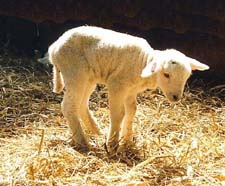Exploring Narnia
I finally saw the new movie version of The Lion, the Witch and the Wardrobe yesterday and it was every bit as wonderful as the reviews led me to believe it would be. I have also just finished rereading the book as a part of reading through the whole series of seven books (I'm now on The Horse and His Boy). I hope that the movie will lead many more folks back into Lewis' writings.
One website with a nice page on Narnia is Welcome to Narnia at reJesus. There you will discover that the books began as series of sketches, that grew into a fairy tale into which the author's faith in Christian faith "pushed itself in of its own accord." The site also tells that,

You might also enjoy a look at Into the Wardrobe: A C.S. Lewis' Site
peace,
Frank+
The Rev. Frank Logue, Pastor + King of Peace Episcopal Church
 Note: Today's religion column in the Tribune & Georgian is the first of two parts. It was originally written as my Christmas Eve sermon for 2003. If you want to look ahead, an illustrated version of the full story is here: Emmanuel: A Shepherd's Story.
Note: Today's religion column in the Tribune & Georgian is the first of two parts. It was originally written as my Christmas Eve sermon for 2003. If you want to look ahead, an illustrated version of the full story is here: Emmanuel: A Shepherd's Story.
One website with a nice page on Narnia is Welcome to Narnia at reJesus. There you will discover that the books began as series of sketches, that grew into a fairy tale into which the author's faith in Christian faith "pushed itself in of its own accord." The site also tells that,

As a child, Lewis had gone to church and known the stories of Jesus, but though he was told how important it was and how much it should mean to him, he never felt it for himself until he was much older.Yet C.S. Lewis respected his child audience enough not to explain the allegorical dimensions. Rather he let the power of story work its own peculiar magic in exciting imaginations. This is very similar to the approach taken by his good friend J.R.R. Tolkein in writing The Lord of the Rings series of books. Hopefully, the movie will encourage a similar fostering of religious imagination. What do you think? Is it obvious enough (or too much so) that Aslan plays the role of Jesus with his sacrificial death? Or should C.S. Lewis have been more (or less) overt?
But as he was writing for children, it occurred to him that if Christ came to them as a talking lion, if he was betrayed by a schoolboy, and cruelly killed, and astonished everyone by coming back from the dead, and if his death set the boy free and his coming back to life ended the eternal winter of Narnia, then maybe readers (and not just children) would grasp and feel the Christian story in a way he never had as a child.
"Supposing", he explained, "that by casting all these things into an imaginary world, stripping them of their stained-glass and Sunday school associations, one could make them appear for the first time in their real potency?" And as he told one parent, "When Laurence thinks he is loving Aslan, he is really loving Jesus: and perhaps loving him more than he ever did before."
You might also enjoy a look at Into the Wardrobe: A C.S. Lewis' Site
peace,
Frank+
The Rev. Frank Logue, Pastor + King of Peace Episcopal Church
 Note: Today's religion column in the Tribune & Georgian is the first of two parts. It was originally written as my Christmas Eve sermon for 2003. If you want to look ahead, an illustrated version of the full story is here: Emmanuel: A Shepherd's Story.
Note: Today's religion column in the Tribune & Georgian is the first of two parts. It was originally written as my Christmas Eve sermon for 2003. If you want to look ahead, an illustrated version of the full story is here: Emmanuel: A Shepherd's Story.







1 Comments:
At 12/19/2005 12:03 PM, The Observer said…
The Observer said…
Having read the Narnia series 25 yrs. ago and rereading them from time to time since then, I feel Lewis' allegory was constructed about as well as anyone could do so. I felt the film was faithful to the book; but it seemed to me that the film managed somehow to "skirt" around the theology Lewis presented us. On the other hand, after reading several Lewis commentaries, it seems he chose to make the allegory obscure (particularly in the case of children) so that later they could recognize Christ from their knowledge of Aslan in the Narnia series.
If you've not read the entire series yet you are in for a treat. I don't believe any book (other than Malcom Boyd's Are You Running With Me, Jesus) has had a more profound effect on my personal theology than Lewis' The Last Battle. But, don't read it until you've finished the other six books of the series. It is most profound.
Post a Comment
<< Home